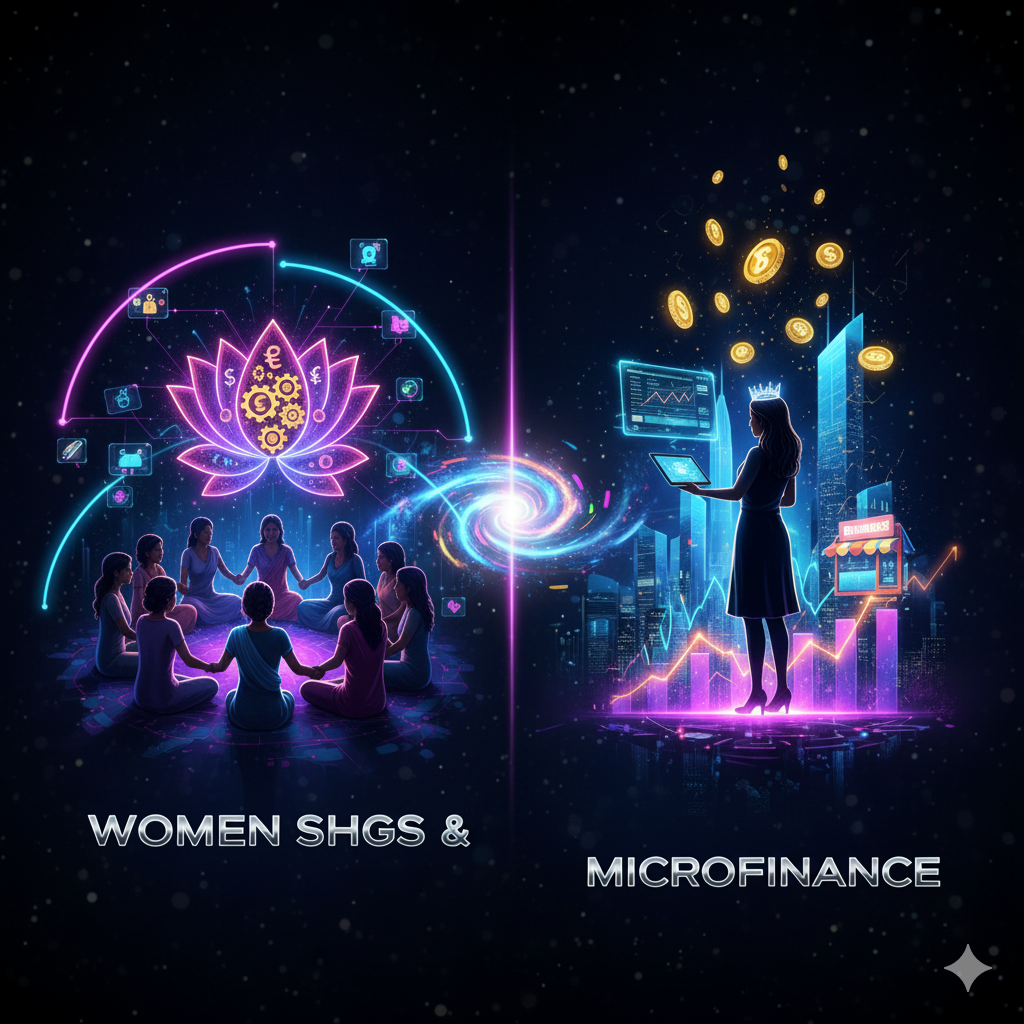Self-Help Groups (SHGs) are informal associations of individuals, typically from similar socioeconomic backgrounds, who come together to address common issues, improve their living conditions, and promote self-reliance. These groups, often composed of 10 to 25 members, primarily focus on savings, credit, and income-generating activities. SHGs have gained prominence, particularly in India, as a means of empowering marginalized communities, especially women, by providing them with access to financial services and fostering a sense of solidarity.
How SHGs Work
- Formation and Structure:
- SHGs are usually formed by non-governmental organizations (NGOs) or community-based organizations.
- Members voluntarily join and contribute small amounts of money regularly, creating a collective fund.
- The groups typically consist of 10 to 25 members, often women, who share similar social and economic backgrounds.
- SHGs are usually formed by non-governmental organizations (NGOs) or community-based organizations.
- Savings and Credit:
- Members save a fixed amount of money regularly, which is pooled together to form a common fund.
- This fund can be used to provide loans to members at low-interest rates for various purposes, such as emergencies, education, or starting small businesses.
- The group members use collective wisdom and peer pressure to ensure proper end-use of credit and timely repayment.
- Members save a fixed amount of money regularly, which is pooled together to form a common fund.
- Linkage with Banks:
- Many SHGs are linked with banks under programs like NABARD’s ‘SHG Bank Linkage’ program, which allows them to access micro-credit.
- Banks provide loans to SHGs based on their savings and repayment history, enabling them to expand their financial capabilities.
- Many SHGs are linked with banks under programs like NABARD’s ‘SHG Bank Linkage’ program, which allows them to access micro-credit.
- Capacity Building:
- SHGs often engage in training and capacity-building activities to enhance members’ skills in various areas, including entrepreneurship, financial literacy, and health awareness.
- This empowerment helps members make informed decisions and improve their livelihoods.
- SHGs often engage in training and capacity-building activities to enhance members’ skills in various areas, including entrepreneurship, financial literacy, and health awareness.
Significance of SHGs
- Empowerment of Women:
- SHGs play a crucial role in empowering women by providing them with financial independence and decision-making power.
- They create a platform for women to voice their concerns and participate in community development.
- SHGs play a crucial role in empowering women by providing them with financial independence and decision-making power.
- Poverty Alleviation:
- By facilitating access to credit and promoting income-generating activities, SHGs contribute to poverty alleviation in rural areas.
- They help members improve their economic status and reduce dependency on moneylenders.
- By facilitating access to credit and promoting income-generating activities, SHGs contribute to poverty alleviation in rural areas.
- Social Capital and Solidarity:
- SHGs foster a sense of community and solidarity among members, encouraging mutual support and cooperation.
- This social capital is essential for addressing broader social issues, such as health, education, and gender equality.
- SHGs foster a sense of community and solidarity among members, encouraging mutual support and cooperation.
- Financial Inclusion:
- SHGs promote financial inclusion by providing access to banking services for marginalized populations who are often excluded from formal financial systems.
- They help members build savings and improve their creditworthiness, enabling them to access larger loans in the future.
- SHGs promote financial inclusion by providing access to banking services for marginalized populations who are often excluded from formal financial systems.
Historical Context
- Origins:
- The concept of SHGs originated in the 1980s in India as a response to the need for financial services among rural populations.
- The first SHGs were formed in the southern state of Tamil Nadu, initiated by NGOs to empower women and promote savings.
- The concept of SHGs originated in the 1980s in India as a response to the need for financial services among rural populations.
- Government Support:
- The Indian government recognized the potential of SHGs in poverty alleviation and women’s empowerment and began supporting their formation and development.
- Programs like the National Rural Livelihoods Mission (NRLM) were launched to promote SHGs and enhance their sustainability.
- The Indian government recognized the potential of SHGs in poverty alleviation and women’s empowerment and began supporting their formation and development.
- Growth and Expansion:
- Over the years, the SHG movement has gained momentum, with millions of groups formed across India.
- As of recent estimates, there are over 2.2 million SHGs in India, representing approximately 33 million members.
- Over the years, the SHG movement has gained momentum, with millions of groups formed across India.
- Global Influence:
- The success of SHGs in India has inspired similar initiatives in other countries, particularly in South Asia and Africa.
- SHGs have become a model for microfinance and community development worldwide.
- The success of SHGs in India has inspired similar initiatives in other countries, particularly in South Asia and Africa.
Challenges Faced by SHGs
- Sustainability:
- Many SHGs struggle with sustainability due to a lack of financial literacy and management skills among members.
- Ensuring regular savings and loan repayments can be challenging, especially in times of economic distress.
- Many SHGs struggle with sustainability due to a lack of financial literacy and management skills among members.
- Access to Markets:
- While SHGs can generate income through small businesses, members often face difficulties accessing larger markets and fair prices for their products.
- Lack of marketing knowledge and resources can hinder their growth.
- While SHGs can generate income through small businesses, members often face difficulties accessing larger markets and fair prices for their products.
- Dependence on External Support:
- Many SHGs rely heavily on external support from NGOs and government programs for training and financial assistance.
- This dependence can limit their autonomy and long-term viability.
- Many SHGs rely heavily on external support from NGOs and government programs for training and financial assistance.
- Social Barriers:
- In some regions, social norms and cultural barriers may restrict women’s participation in SHGs or limit their ability to take on leadership roles.
- Addressing these barriers is essential for the success of SHGs.
- In some regions, social norms and cultural barriers may restrict women’s participation in SHGs or limit their ability to take on leadership roles.
Conclusion
Self-Help Groups (SHGs) have emerged as a powerful tool for community development, particularly in empowering women and alleviating poverty. By promoting savings, providing access to




